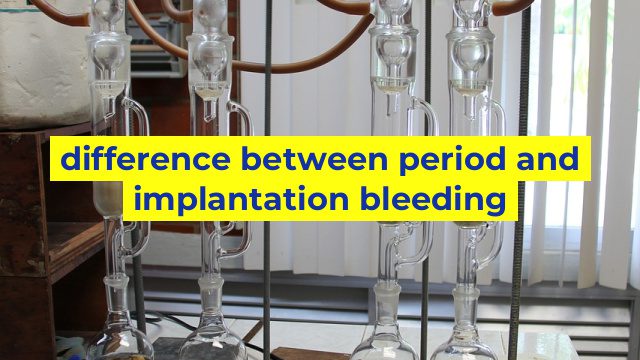The Difference Between Period and Implantation Bleeding
When it comes to women’s health, there are a lot of things that can cause concern. One of the most common concerns is the appearance of bleeding, particularly when it comes to menstrual bleeding and implantation bleeding. These two types of bleeding can look similar, but they have important differences that can help women understand what’s happening in their bodies.
What is Period Bleeding?
Period bleeding, also known as menstrual bleeding, is a normal part of the menstrual cycle. It occurs when the lining of the uterus sheds, and it typically lasts for 3-5 days. The amount of blood can vary from person to person, but it is typically heavier than implantation bleeding.
Period bleeding usually follows a consistent pattern and occurs at the same time each month. It is also accompanied by other symptoms, such as cramping, bloating, and mood swings. Women may also experience headaches, fatigue, and breast tenderness during their period.
What is Implantation Bleeding?
Implantation bleeding, on the other hand, is not as common as period bleeding. It occurs when a fertilized egg implants itself in the lining of the uterus, which can cause some bleeding. Implantation bleeding typically occurs 10-14 days after conception and can last for a few hours up to a few days.
Unlike period bleeding, implantation bleeding is usually light and is often mistaken for spotting. It may also be accompanied by mild cramping or no symptoms at all. Women who are not actively trying to conceive may not even realize they are experiencing implantation bleeding.
The Differences Between Period and Implantation Bleeding
There are several key differences between period and implantation bleeding that women should be aware of. First, period bleeding is typically heavier than implantation bleeding. Second, period bleeding follows a consistent pattern and occurs at the same time each month, while implantation bleeding can occur at any time during the menstrual cycle.
Third, implantation bleeding is usually light and may be mistaken for spotting, while period bleeding is usually heavier and lasts for several days. Fourth, period bleeding is accompanied by other symptoms, such as cramping, bloating, and mood swings, while implantation bleeding may be accompanied by mild cramping or no symptoms at all.
When to See a Doctor
If you are experiencing abnormal bleeding or are unsure whether you are experiencing period or implantation bleeding, it is important to see a doctor. They can help determine the cause of the bleeding and make sure everything is working properly.
In conclusion, although period and implantation bleeding can look similar, they have important differences that can help women understand what’s happening in their bodies. Understanding these differences can help women take control of their health and be more informed about their menstrual cycle.
Table difference between period and implantation bleeding
| Period Bleeding | Implantation Bleeding |
|---|---|
| Occurs regularly | Occurs irregularly |
| Lasts 3 to 7 days | Lasts 1 to 2 days |
| Heavy bleeding | Light spotting |
| Accompanied by cramps and mood swings | Minimal or no cramps |
| Occurs in the menstrual cycle | Occurs during pregnancy |
| Color may range from bright red to brown | Light pink or brown discharge |
| Generally not a sign of pregnancy | May indicate pregnancy |
